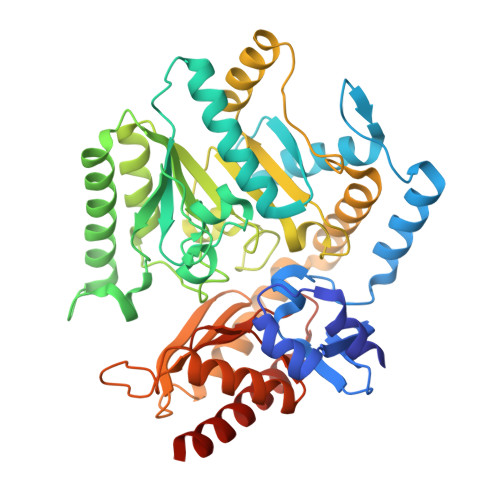Computational Redesign of an omega-Transaminase from Pseudomonas jessenii for Asymmetric Synthesis of Enantiopure Bulky Amines.
Meng, Q., Ramirez-Palacios, C., Capra, N., Hooghwinkel, M.E., Thallmair, S., Rozeboom, H.J., Thunnissen, A.W.H., Wijma, H.J., Marrink, S.J., Janssen, D.B.(2021) ACS Catal 11: 10733-10747
- PubMed: 34504735
- DOI: https://doi.org/10.1021/acscatal.1c02053
- Primary Citation of Related Structures:
7B4I, 7B4J - PubMed Abstract:
ω-Transaminases (ω-TA) are attractive biocatalysts for the production of chiral amines from prochiral ketones via asymmetric synthesis. However, the substrate scope of ω-TAs is usually limited due to steric hindrance at the active site pockets. We explored a protein engineering strategy using computational design to expand the substrate scope of an ( S )-selective ω-TA from Pseudomonas jessenii ( Pj TA-R6) toward the production of bulky amines. Pj TA-R6 is attractive for use in applied biocatalysis due to its thermostability, tolerance to organic solvents, and acceptance of high concentrations of isopropylamine as amino donor. Pj TA-R6 showed no detectable activity for the synthesis of six bicyclic or bulky amines targeted in this study. Six small libraries composed of 7-18 variants each were separately designed via computational methods and tested in the laboratory for ketone to amine conversion. In each library, the vast majority of the variants displayed the desired activity, and of the 40 different designs, 38 produced the target amine in good yield with >99% enantiomeric excess. This shows that the substrate scope and enantioselectivity of Pj TA mutants could be predicted in silico with high accuracy. The single mutant W58G showed the best performance in the synthesis of five structurally similar bulky amines containing the indan and tetralin moieties. The best variant for the other bulky amine, 1-phenylbutylamine, was the triple mutant W58M + F86L + R417L, indicating that Trp58 is a key residue in the large binding pocket for Pj TA-R6 redesign. Crystal structures of the two best variants confirmed the computationally predicted structures. The results show that computational design can be an efficient approach to rapidly expand the substrate scope of ω-TAs to produce enantiopure bulky amines.
Organizational Affiliation:
Biotransformation and Biocatalysis, Groningen Biomolecular Sciences and Biotechnology Institute (GBB), University of Groningen, Nijenborgh 4, AG Groningen 9747, Groningen, The Netherlands.
















